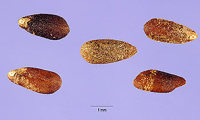Hyssop Characteristics
(Hyssopus officinalis, Linn.)

Name Origin:
The name comes from the Greek word hyssopos and the Hebrew word for Azob, a holy herb, used for cleaning sacred places.
Read more on the History of Hyssop.
Natural Order:
Labiatæ
Growing Cycle:
Perennnial, evergreen
Origins:
Native of the Mediterranean region.
Height:
Hyssop grows to 2 feet tall
Growing Habit:
Bushy evergreen with smooth and simple stems.
Hyssop Flowers:
Clusters of blue, though sometimes pink or white, flowers growing in clusters from a spike originating on the main branch.
The gorgeous hyssop photograph is the work of H. Zell who generously shared his work under the terms of the Creative Commons Attribution-Share Alike 3.0 Unported license.
Growing Hyssop
(Seeds, sowing, cultivation, propagating and harvesting)
Growing Hyssop From Seeds

Hyssop grows best in warm, limy soil and partially shaded. If soil is too rich, the plants will become very lush and be less aromatic.
Sow hyssop seed in early spring in a cold frame or in the open. Hyssop seeds require light to germinate properly so only lightly cover seeds to ensure the greatest yield from your seeds.
Hyssop is a favorite of bees and butterflies. It makes an effective companion plant for a number of reasons. Please check out our hyssop companion planting guide before adding hyssop to your herb garden.
Cultivation.
Transplant seedlings in early summer. Plants should be placed no closer than 6 inches in rows that are 18 inches apart. For best yields plants should be renewed every 3-4 years.
Hyssop Propagation.
Hyssop can be readily propagated through divisions and cuttings. Cuttings should be taken in spring or autumn.
Harvesting.
Collect the flowers and green tops when the plant begins to flower. The flowers and leaves can be used fresh or dried and stored in an airtight container.
Hyssop Uses
(leaves, flower tops and hyssop oil)
Hyssop Leaves.
Hyssop leaves are often added to salads, fruit pies and broths to add a slightly bitter taste. It is often used to accompany greasy meat or fish as hyssop tends to aid the digestion of fat. It’s also a good addition to stuffings and sausages.
Flower Tops.
The flower heads of hyssop are distilled into an oil used as an expectorant.
Hyssop Oil.
Used in the manufacture of liqueurs, with Chartreuse being the most popular, and in the manufacture of perfumes.
